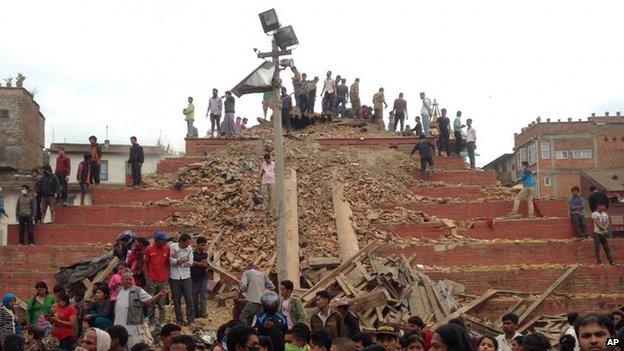Why Nepal is so vulnerable to quakes
- Published

Historic landmarks were wrecked in the earthquake
The pictures emerging from the Nepalese capital, Kathmandu, are shocking.
Durbar square, a Unesco World Heritage Site, has been reduced to rubble. The famous Dharahara Tower has been toppled to leave just a stump.
Nepal is used to quakes – this is one of the most seismically active regions in the world. You only have to look at the Himalayas to understand that.
The mountains are being built as a consequence of the Indian tectonic plate driving under Central Asia (the Eurasian tectonic plate). These two great slabs of the Earth's crust are converging at a relative rate of about 4-5cm (two inches) a year.
The upward climb of Everest and its sister mountains is accompanied by numerous tremors.
David Rothery, a professor of planetary geosciences, at the Open University, UK, commented: "The Himalayan mountains are being thrust over the Indian plate; there are two or three big thrust faults, basically. And some very gently dipping fault will have been what moved, and gave us this event. Casualties are reported in Kathmandu, but we now wait to see how widespread the problems are."
Vulnerable buildings
Initial estimates of casualties, even in the biggest quakes, usually start off small, and then grow.
In the case of this quake, the fear will be that the final numbers could be quite high.
That's not just because the magnitude of the main event was large – at M7.8 (numbers will be revised as more data is assessed) – but that it was also very shallow – a mere 10-15km down.
This will have made the shaking felt at the surface extremely severe. And in the four hours that followed the main event, at least 14 aftershocks were recorded, most of them magnitude fours and fives, but including a Magnitude 6.6.
Remember, every step down on the scale constitutes a 30-times drop in the energy released, external in an event, but when buildings are already damaged, the smaller aftershock may be all that's required to bring a structure crashing to the ground.
And the assessment is that much of the population in this region live in houses that are highly vulnerable to earthquake shaking: unreinforced brick masonry and the like.
Landslide risk
One of the big concerns, based on previous experience, will be the possibility of landslides.
In places in this mountainous terrain, there could well be villages that are cut off, even destroyed by mud and rock that has come tumbling off steep slopes.
It will all add to the confusion as the authorities try to deal with the emergency, and will mean that information will be slow to emerge and sometimes conflicting.
Looking right across the Himalaya region, other significant earthquakes include the 1934 M8.1 Bihar event, the 1905 M7.5 Kangra tremor and the 2005 M7.6 Kashmir quake.
The latter two events were particularly harsh, resulting in loss of life that topped 100,000. Millions were also left homeless.